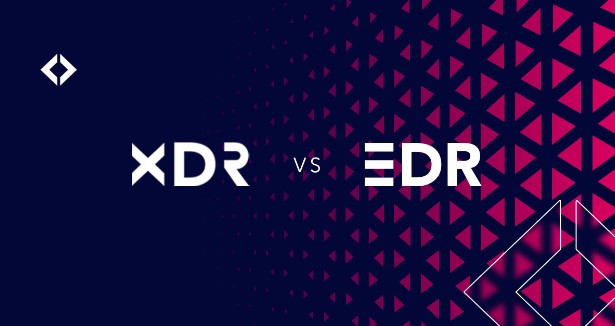Ransomware Attacks have become the biggest challenge for businesses of every size and scale. According to Sophos Research, organizations encounter ransomware attacks 29% due to file downloads or emails with malware attachments. Remote attacks on servers are quite prevalent. 21% times, Cybercriminals use phishing techniques to initiate a ransomware attack on endpoints and servers.
So, when dealing with cyber threats, two common solutions are EDR and XDR. They help your organization prevent these attacks and automate threat response. Since you can't get both, you always wonder what the difference between EDR and XDR is. This comparison helps you decide which option you should opt for. Let's continue reading and find the complete details.

It is an endpoint security solution that offers advanced protection against threats lurking on your endpoints. An EDR agent offers multi-layer advanced security. It continuously monitors all the endpoints and collects the data and activities for analytics.
It can detect, prevent, and stop threats while automating response. This software also generates alerts for IT Administrators, so they can analyze malicious events and behavior and take preventive measures.
Main Purpose of EDREDR is software designed to offer security to endpoint users. With the evolution of remote work culture, your endpoints have become the most vulnerable points. Cybercriminals often target endpoints by accessing employee IDs or Passwords or using some USB-based malware attack.
Regardless of threat actors' methods, once an endpoint is compromised, it's not that tricky for criminals to control your whole system. All endpoints are connected, and infection of one endpoint often leads to a complete network compromise.
Once you have an Endpoint Detection and Response system, it helps you monitor all the endpoints. If a malicious attack happens on an endpoint, the tool will readily detect it. Getting an EDR is to detect, prevent, and respond to malicious attacks such as ransomware, social engineering, phishing, and others on endpoints. With an Endpoint protection tool, your team becomes proactive with threat hunting and response.
You have got an idea about the Endpoint detection tool. Before you get an answer to the difference between XDR and EDR, it's vital to understand what XDR is and what its main purpose serves in your organization.
What is XDR- Extended Detection and Response?This software is designed to offer extended detection and response for the entire organization's IT Infrastructure, which comprises endpoints, cloud infrastructures, networks, servers, and much more. Your enterprise infrastructure comprises a wide variety of systems.
When you want to protect every aspect of this structure, it's where XDR comes in handy. It offers comprehensive and 360-degree protection.
This tool offers visibility across an organization's entire infrastructure. Your security team can get an insight into the complete system from a single dashboard.
Once you have an XDR solution, it can help you identify sophisticated threats. You can block malicious content from harming the whole system. It becomes easy for your team to mitigate in-process attacks readily through great visibility.
What is the main purpose of XDR?Your organization employs different security systems to detect and prevent threats across different components of IT infrastructures, such as servers, mobile devices, endpoints, etc. Getting an XDR is to integrate all these security systems into one place. You can control all security systems from one single pane.
EDR vs XDR - What is difference between EDR and XDR
Here are some points of difference between both options:
Security CoverageThe endpoint security tool only offers endpoint protection. So, its security cover is limited. Irs agent alerts your IT analysts and temporarily contains the threat in the sandbox.
For example, the Xcitium Endpoint detection and response system has a containment system where malicious files and activities are run exclusively. Once the system detects the threat, it responds to it.
However, XDR is extended protection because it covers all the components of IT Infrastructure. This tool integrates all the security components from the cloud, email, endpoints, servers, etc. When you need to take a 360 view of an organization's cybersecurity, this softwares offer detailed insights.
What is difference between EDR and XDR Integration Point
EDR offers dedicated protection on endpoints. Your team can enjoy next-level threat intelligence, detection, prevention, and response through it. Contrary to this, XDR is designed to integrate all the security solutions at one point, thereby simplifying your organization's security architecture.
When you have the Xtended detection tool, you no longer need to switch from one system to another to get complete insight. The security management process becomes simpler when you have this tool.
What is Difference between XDR and EDR? - Key Takeaway
Finally, you get a detailed answer to the question. When your organization is looking for the best endpoint security, only then does Endpoint detection and response seem like an amazing choice.
However, when you want security management and protection, Xtended detection and response certainly let you secure your overall organization's IT Infrastructure.
